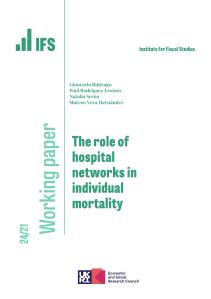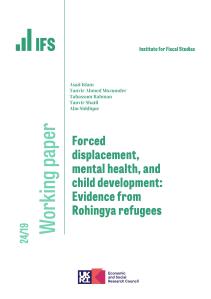Public spending on social care for older people in England has seen large cuts in recent years, falling by 21% between 2009–10 and 2015–16. This has led to growing concerns over the potential for adverse effects on other public services, and in particular the NHS. A new IFS working paper, funded by the Health Foundation and the ESRC, examines the impact of reductions in local authority social care spending on the use of NHS Accident and Emergency (A&E) departments, and finds that these cuts have directly led to increased use of A&E services by people aged 65 and over.
Recent years have seen large reductions in the budgets of local authorities in England, which have led to pressure on many of the services provided. Social care for older people is no exception, with local authority funding for these services for people aged 65 and over falling in real terms by an average of 21% between 2009–10 and 2015–16. This has not only led to large falls in the numbers of people aged 65 and over receiving social care – between 2009−10 and 2013−14 the number of recipients fell by a quarter, and it is likely that the number has continued to fall since – but also in growing concerns over the potential for adverse knock-on effects of these cuts on to other public services, and in particular the NHS.
A new IFS working paper, published today and funded by the Health Foundation and the ESRC, examines the impact of reductions in local authority social care spending in England on the use of NHS Accident and Emergency (A&E) departments. A&E departments have experienced large increase in the number of older patients in recent years, with the number of A&E attendances by individuals aged 65 and over increasing by 35% from 2.9 million to 3.9 million between 2009–10 and 2015–16.
The paper exploits the geographical variation in the level of social care spending across England and differences in the size of the subsequent cuts, and finds that cuts to social care spending between 2009–10 and 2015–16 have directly led to increased use of A&E services by older individuals. Over this period, the average reduction in local authority spending on social care was £375 for every person aged 65 and above. Our central estimate implies that a cut in per person social care spending of this size increased the number of A&E visits by 0.09 per person aged 65 and over per year: that is, almost one additional A&E visit for every ten residents aged 65 and above. This compares to an average of 0.37 visits per resident aged 65 and above in 2009–10.
The increase in the average number of A&E visits can be explained both by an increase in the number of individuals using A&E in a year, and an increase in the average number of times that a patient attends A&E. The central estimates indicate that the average reduction in per person spending on social care (£375) increased the proportion of those aged 65 and over making at least one visit to A&E by 3.8 percentage points. This means that an additional four people attended A&E in 2015–16 for every 100 persons aged 65 and above directly as a result of cuts to public spending on social care. For comparison, just under one-in-four (23%) of those aged 65 and over visited A&E at some point during 2009–10.
Cuts to social care spending have therefore increased the use of NHS A&E services. Our central estimates imply that this has led to a modest rise in the costs of providing A&E care over time, or an additional £3 for every £100 cut to per capita social care spending. This suggests that while some of the cuts to social care spending are not a genuine saving to the public sector, at least in terms of the offsetting increase in pressures on NHS A&E services, the increased financial burden is modest.
The paper also suggests that the impacts of the cuts are more evident among the oldest age groups. While data are not available on social care spending over individual ages, we can examine the impact of a cut to spending on those aged 65 and over on the NHS A&E use of different age groups. The results indicate that the effect of the cuts on the number of NHS A&E visits was 1.6 times larger among individuals aged 85 and over than among those aged between 65 and 74. So it does appear that it is the oldest individuals who were more likely to go to A&E as a direct result of the cuts to social care.
These results confirm that hospital and social care are somewhat interdependent. However the extent of these spillovers is still not fully understood. Reductions in social care budgets have in part been met by reductions in the number of social care recipients. These reductions have often been targeted on those deemed to have the least severe care needs. If cuts continue into the future, it is likely – perhaps inevitable – that individuals with increasingly severe needs would be affected. Impacts of future cuts may therefore be larger and better understanding of the consequences – for informal care, private care and NHS hospitals – should be a priority for researchers and policymakers.
This research does not consider the impact of social care cuts on wider NHS services such as GP practices, or on the wider impact on the quality of life experienced by users (or potential users) of social care or informal carers (or potential informal carers). Future research therefore has many important outcomes to study in detail. But given the considerable pressures facing health and social care over the next fifteen years, and with a new funding settlement for the NHS perhaps on the horizon, this research is a timely reminder that the two systems should not be considered in isolation.
This work was funded by the Health Foundation through the Efficiency Research Programme, and by the Economic and Social Research Council through the Centre for the Microeconomic Analysis of Public Policy at IFS (ES/M010147/1) and the 'Policies for longer working lives: understanding interactions with health and care responsibilities' project (grant number ES/P001688/1) that is part of the Joint Programme Initiative “More Years, Better Lives”.










